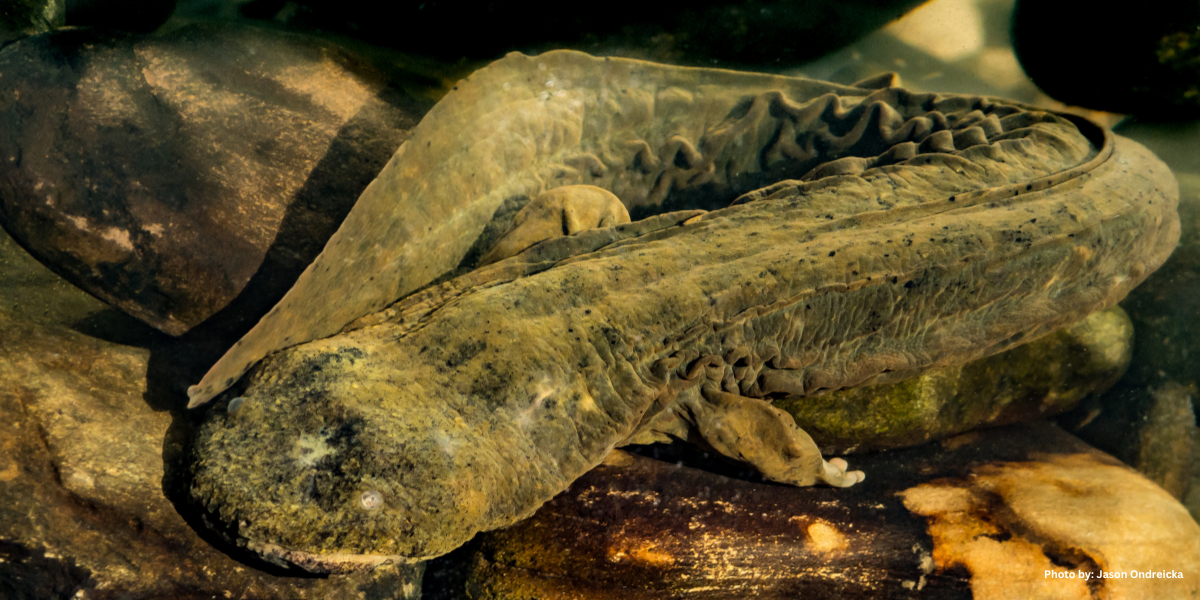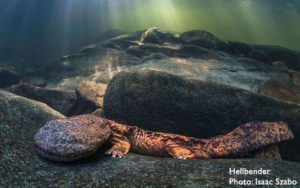“Clearing the Water” Around the Eastern Hellbender

What comes to mind when you think about the North Carolina Mountains? Perhaps the sound of bluegrass music, the taste of a hearty soup on a bitter cold day, or the sight of a wide-open view filled with peaks and rolling hills tinged with blue. One feature of the North Carolina Mountains that may get overlooked, is the extensive network of creeks, streams and rivers that harbor an ecosystem filled with life. Life that includes giant salamanders, if the conditions are right.
Allegheny alligator, devil dog, snot otter. These are just a few nicknames given to one of the most iconic North Carolina species…. the eastern hellbender (Cryptobranchus a. alleganiensis).
 North Carolina is home to more than 56 species of salamanders. The hellbender stands out as the largest in the state and one of only three giant salamanders found in the world. Despite their size (averaging 16-17 inches in length and sometimes weighing more than three pounds), seeing one is no easy task. They are masters of disguise. As many of their nicknames imply, the skin on the eastern hellbender is dark and mudlike, camouflaging them from predators and unsuspecting prey.
North Carolina is home to more than 56 species of salamanders. The hellbender stands out as the largest in the state and one of only three giant salamanders found in the world. Despite their size (averaging 16-17 inches in length and sometimes weighing more than three pounds), seeing one is no easy task. They are masters of disguise. As many of their nicknames imply, the skin on the eastern hellbender is dark and mudlike, camouflaging them from predators and unsuspecting prey.
Like many species of salamander, hellbenders live long lives as compared to other wildlife species. It is not uncommon for an eastern hellbender to live for at least 30 years.
Hellbenders live in rivers and large streams with clean, clear, and fast-moving water containing high oxygen levels. They need large, flat rocks and submerged trees both to make nest sites and protect themselves from predators. If the preferred flat rocks are not available, hellbenders will also shack up in holes in streambanks.
Though they mostly eat crayfish, hellbenders may eat the occasional fish. However, contrary to popular belief, hellbenders have little impact on fish populations and are not a danger to the quality of trout fisheries.
Hellbenders are super sensitive to silt, sedimentation and water pollution. Because of this, they are considered biological indicators of water quality. As the N.C. Wildlife Resources Commission (NCWRC) puts it, “if there is a healthy hellbender population in a stream, there is clean water.”
If you come across a hellbender (maybe while you’re on the Blue Ridge Snorkel Trail) it’s important to not harass them or disturb their habitat. The hellbender is a species of Special Concern and listed as a Species of Greatest Conservation Need in the Wildlife Action Plan.
As a Species of Greatest Conservation Need, the eastern hellbender would benefit from the passage of Recovering America’s Wildlife Act (RAWA). If passed, RAWA would send more than $20 million annually to the North Carolina Wildlife Resources Commission, which would use the money to help nearly 500 nongame fish and wildlife identified species of greatest conservation need. The preservation of this species, among others, relies on our stewardship alongside extensive conservation efforts and proper management of North Carolina’s natural resources.
If you find an eastern hellbender, make sure to report your sighting to the NCWRC.
Check out the NCWRC’s species profile on the eastern hellbender for more information.

– Luke Bennett, NCWF Conservation Coordinator

